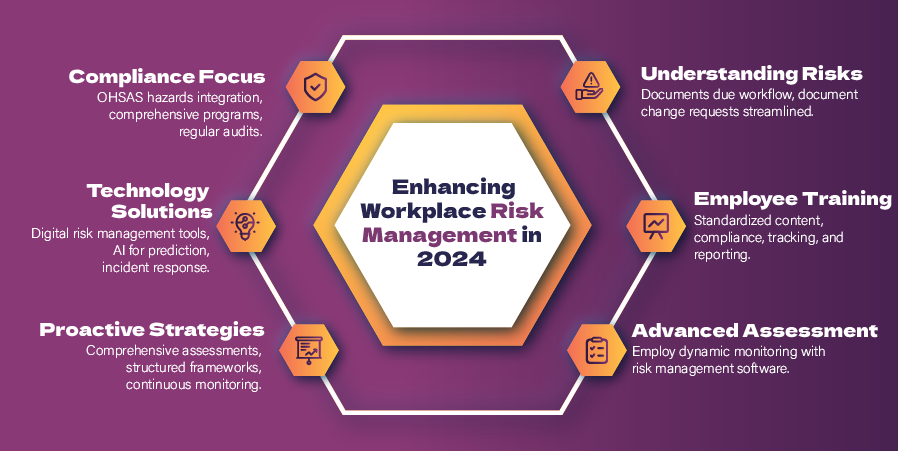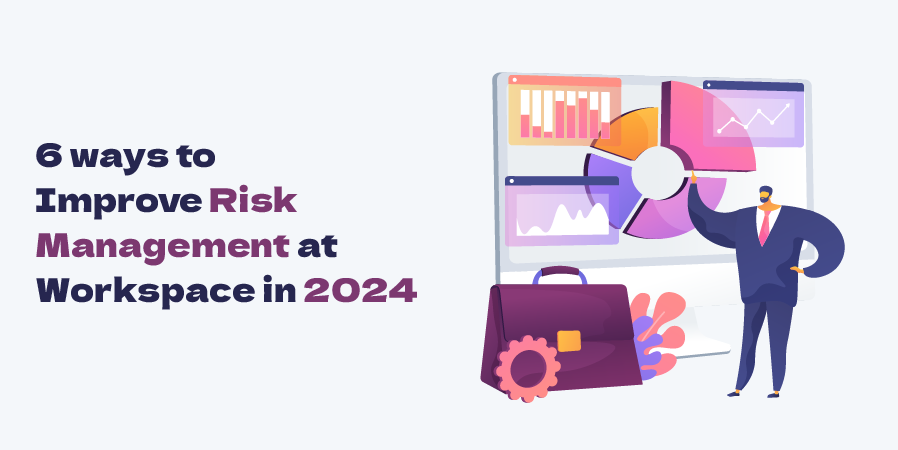Master Risk Management at Work in 2024!
In 2024, workplaces are quickly evolving to include new working styles, technology and challenges.This means the risks in your workplace are also evolving. With new risks and threats on the rise you need a risk management at work.
Technology can be of great help when managing risks in modern workplaces. Digital tools can help with identifying and mitigating risks without causing escalations or workplace hazards. This allows your organization to stay in line with compliance and regulatory frameworks that are mandated legally.
Let's look at the 6 ways to improve risk management at work in 2024 by leveraging advanced technological tools.

1. Understanding Risks in 2024
The first step in risk management at work is to understand the various types of risks that you may face in the modern-day workplace. In 2024, an understanding of risks has to expand beyond the traditional risks in a workplace to include those caused by the increase in the use of digital technologies.
The following aspects must be considered for identifying the effective risk & opportunity and navigating the complex risk environment successfully.
Traditional Risks in the Workplace
Traditional workplace hazards are the primary cause of risks at the workplace. These range from physical injuries in high-risk sectors to health risks in office spaces. In such contexts, controlling risks involves identifying and evaluating potential hazards and mitigating dangers early on.
Digital Risks in the Workplace
The digital transformation of workplaces has expanded the scope of risks to include threats like cyberattacks, data breaches and privacy concerns. Handling these threats requires strategies for digital risk management.
With both types of risks, traditional or digital, the first step is to identify and evaluate them within your specific organizational context and environment. Using a risk management software solution can help you identify potential risks based on data collected from your workplace and help you implement a customized plan to mitigate such risks.
2. Improved Employee Training and Awareness
Training programs focused on how to manage risks and workplace safety strategies must be essential components of your risk management strategy. Employees are usually responsible for responding to risks and aiding in the process of identifying them. This means their awareness and preparedness cannot be overlooked. Here's how you can use your integrated management software (IMS) to prepare your employees for risk handling:
-
Standardization of Training Content: Software can help you standardize training content across your organization and ensure that all the employees receive high-quality information on risks.
-
Tracking and Reporting: With Quality Management Software, you can track employees' progress, assess their understanding and generate reports on training outcomes. You can then use this information to identify gaps in risk-related knowledge and provide additional training.
-
Compliance: The IMS software also helps ensure that all your training programs meet compliance and safety standards. This helps your organization stay compliant and protects you from severe penalties and fines.
3. Advanced Risk Assessment Techniques
With changing workplaces you need to employ advanced risk assessment techniques into your workplace risk management strategy. You can do this with the help of risk management software. The software supports dynamic monitoring of risks which is essential for fast paced industries where new risks emerge unexpectedly and need to be managed quickly.
For example, consider risk management in the healthcare industry, where risks can impact patient safety and data security, digital risk management tools can easily identify potential threats and mitigate them.
4. Improve Compliance
Most regulatory frameworks and standards require you to have an efficient and proactive risk management strategy in place. These frameworks often include requirements for maintaining operational health and safety in your everyday work environment. Ensuring compliance with these regulations can help you mitigate risks that your organization may face. Here are some strategies to consider:
-
Focus on OHSAS Hazards: Pay particular attention to OHSAS Hazards Integrating management systems and tools focused on OHSAS can reduce workplace hazards and create a safer environment for employees.
-
Implement a Holistic Compliance Program: Develop a comprehensive program that addresses all aspects of compliance. This includes employee training and operational procedures to ensure every facet of your organization aligns with regulatory requirements and is free of risks.
-
Conduct Regular Compliance Audits: Regular audits and assessments can help identify areas with increased potential for risks. Identifying such areas early on helps implement compliance and risk management strategies.
5. Use Technology Based Solutions
Digital risk management is the way to go for all workplaces in 2024. Here's how you can leverage technology for risk management at work:
-
Adopt Digital Risk Management Solutions: Implement software that specializes in identifying, analyzing and mitigating digital risks. Such software offers real-time monitoring and alerts to keep you aware of potential risks. Software solutions provide insights into risk and opportunities in terms of emerging trends and areas for growth.
-
Incorporate AI and Machine Learning: AI-driven tools can predict potential security threats by analyzing patterns and anomalies in data. This proactive approach helps in controlling risks in a digital landscape.
-
Incident Response Capabilities: Develop robust incident response plans with the help of technology. Quick and efficient response to digital incidents minimizes potential damage and downtime.
6. Create Strategies for Proactive Management
Proactive management is key to effectively controlling risks and ensuring risk handling is both efficient and effective. Here's how you can develop strategies for proactive risk management:
-
Comprehensive Risk Assessment Tools: Use software that offers extensive risk assessment features, enabling you to identify and evaluate risks before they materialize.
-
Risk Management Framework: Create a structured strategy for risk handling that includes policies, procedures and tools that are customized to your specific business needs.
-
Continuous Monitoring Systems: Implement monitoring systems that provide continuous oversight of risk indicators. This allows for immediate detection and controlling of risks.
Final Thoughts
Risk management at work is a multi-step process and requires a comprehensive strategy in place. You can make this process more efficient and save on both time and resources by implementing risk and management system.
Leveraging technology in risk management can help you make data-driven decisions, standardize employee training on risk prevention, implement organization-wide risk management protocols and stay compliant with legal and regulatory requirements.






























